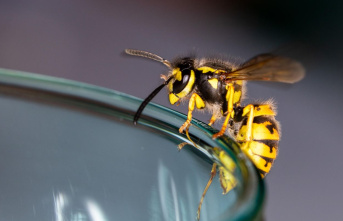Usually tea is brewed with hot water so that the full aroma can develop. If you then let it cool down, we perceive the taste more clearly than the smell of the drink. This gives many varieties a bitter note, as we taste the so-called tannins more strongly than the aroma. For this reason, finished iced tea mixtures are also heavily sweetened to balance out the bitter or tart aftertaste. If, on the other hand, the tea is poured with cold water, fewer tannins are released - this means that it tastes much gentler because we perceive the aroma better. However, not every variety is suitable for the “cold brew” method. Why this is the case and which types of tea can be enjoyed cold without any problems is explained as follows.
There is a good reason why herbal, rooibos or fruit teas in particular are first poured with bubbling hot water and have to steep for a while before they are ready to drink: the tea types are only dried after harvesting - and are not subjected to any greater heat during further processing exposed so that bacteria and germs or mold can stick to it. If the tea is then only poured with cold water, it can pose a health risk, especially for small children and sick people. However, if the tea is brewed, the hot water combined with the steeping time kills possible pathogens.
While herbal, rooibos or fruit teas should always be brewed (regardless of whether you want to drink them warm or cold), the following varieties are also suitable for cold brewing: green tea, black tea, oolong tea or white tea. The leaves are heated during processing, which means they are largely germ-free. With the so-called "cold brew" method, the contents are simply poured over with cold tap or mineral water - and left to steep for several hours. This allows the tea to develop its full flavor without losing its intense aroma. The bitter substances it contains can only dissolve slowly due to the cold temperature.
In contrast to homemade iced tea, which must first be brewed and then kept cold, cold brew tea is dissolved in cold water - and has to sit for several hours so that the ingredients can spread slowly and gently. This makes the result taste significantly milder, which is due to the amino acids, which dissolve better in cold temperatures and give the tea more sweetness. When preparing it, it is important that the colder the water, the longer the tea leaves have to steep: Take two teaspoons of your favorite variety and dissolve them in one liter of water. Place the drink in the refrigerator for at least two hours (or overnight) and then fish out the tea residue with a sieve.
In addition to the tried and tested classics, there are now also tea blends that have been developed specifically for cold infusions: well-known manufacturers such as Milford offer, in addition to the summer iced tea varieties peach and lemon, other flavors for cold brewing, such as elderflower-lime, raspberry-cherry, melon or orange. Peach. And Teekanne has also expanded its range to include cold “frio” tea: In addition to lime-mint and peach-passion fruit, there are currently raspberry-lemon and strawberry-orange. Even a separate “sports edition” has made it into the range. The special thing about these varieties is that you don't have to steep for several hours (as with the cold brew method), but are ready to drink after just five to eight minutes of steeping time. This is made possible by processing the tea leaves differently.
This article contains so-called affiliate links. Further information are available here.












